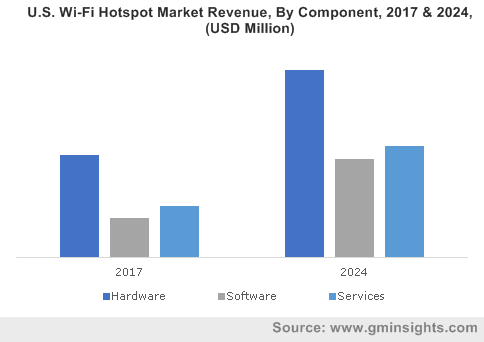Wi-Fi Hotspot Market Size to exceed $23bn by 2024
Published Date: October 2018
Wi-Fi Hotspot Market size is set to exceed USD 23 billion by 2024; according to a new research report by Global Market Insights Inc.
The Wi-Fi hotspot market is propelled by the growing number of government initiatives to develop high-speed Wi-Fi infrastructure. Government authorities are intensively involved in the development of public Wi-Fi infrastructure to nurture digital inclusion. The governments are deploying millions of Wi-Fi Hotspot devices across public access and government offices to provide free Wi-Fi services. Government organizations are working with telecom service providers, internet service providers, and technology players to provide unlimited economical services to individuals.
Technological advancements in the WLAN technology and the increasing integration of IoT devices are also accelerating the adoption of Wi-Fi hotspot market. Technological advancements in the IoT have allowed the Wi-Fi technology to be used for more than just connecting to internet services. Wi-Fi is used for creating an interconnected network of multiple smart devices. It also transforms smartphones into remote-controlled devices for ACs and televisions and enables communication between multiple devices connected to the Wi-Fi network.

Get more details on this report - Request Free Sample PDF
The limited frequency range of the technology is restraining the Wi-Fi hotspot market growth. Inherent limitations associated with the range and multipath interference of the Wi-Fi technology restrict user mobility. The radio frequency signals of Wi-Fi hotspots are subject to the limitations posed by structural properties of a hotspot location. The radio frequency of a typical Wi-Fi hotspot device cannot reach beyond 20 to 25 meters.
Hardware Wi-Fi hotspot market is expected to grow significantly over the forecast time with a CAGR of approximately 11%. The hardware segment is driven by an increasing demand for mobile hotspot devices. Mobile hotspot devices allow users to connect to the internet service via 3G, 4G, and LTE networks. It is equipped with an LCD screen that displays signal strength, data consumption, and real-time network status. The increasing adoption of Wi-Fi services in automotive and the growing adoption of the smartphones are the major forces accelerating the adoption of mobile Wi-Fi hotspot devices. The software segment is anticipated to grow substantially during the projected timeline. The Wi-Fi hotspot market is propelled by a growing demand for the cloud-based software among enterprises. The cost-effectiveness, scalability, and the flexibility offered by cloud models are the primary factors driving the demand.
Browse key industry insights spread across 400 pages with 752 market data tables & 32 figures & charts from the report, “Wi-Fi Hotspot Market Size By Component (Hardware [Gateways, Controllers, Mobile Hotspot Devices], Software [Hotspot Management, Security Software, Billing, Cloud-based], Services [Professional, Managed]), By Application (Commercial [Trains, Hotels, Planes, Municipalities, Retail, Airports, Cafes], Community [Residential, Business]), Regional Outlook, Growth Potential, Competitive Market Share & Forecast, 2018 – 2024” in detail along with the table of contents: https://www.gminsights.com/industry-analysis/wi-fi-hotspot-market
The commercial application segment in Wi-Fi hotspot market is anticipated to register a high growth rate over the projected time. The retail Wi-Fi hotspot market is expected to grow rapidly due to the widespread adoption of Wi-Fi hotspot services at retail establishments. The retailers are using Wi-Fi-assisted technologies such as the IoT, mobile applications, and POS systems to predict their customer behavior and create a more personalized experience. The residential segment is expected to grow due to the increasing data traffic caused by the rising consumption of rich media content. Moreover, the growing disposable income of consumers is also driving the residential Wi-Fi hotspot market.
The North America region holds a share of more than 25% in the Wi-Fi Hotspot market. The presence of highly-developed network infrastructure along with high penetration of internet service and smartphone adoption fosters the demand for the Wi-Fi Hotspot devices. The widespread adoption of Bring Your Own Devices (BYOD) and enterprise mobility solution among organizations also promote the deployment of Wi-Fi hotspot market. In addition, the presence of prominent companies such as Cisco, AT&T, and Verizon is supporting Wi-Fi hotspot market growth.
The players operating in the Wi-Fi hotspot market are Ipass, Aruba Networks, Nokia Networks, Ruckus Wireless, Alcatel-Lucent, Aptilo Networks, Motorola Solutions, Cisco Systems, Netgear, Ericsson, Boingo Wireless, and Ubiquiti Networks. The companies are focused on entering into strategic partnerships with other vendors to strengthen their product capabilities and increase their customer base. For instance, in 2017, Ruckus Networks launched its Technology Ecosystem Partner Program to offer complete and proven solutions for network application needed to complement its Wi-Fi hotspot portfolio and help customers meet critical business needs.
The global Wi-Fi Hotspot market research report includes an in-depth coverage of the industry with estimates & forecast in terms of installed base in units and revenue in USD respectively from 2013 to 2024, for the following segments:
Wi-Fi Hotspot Market, By Component
- Hardware
- Gateways
- Controllers
- Mobile Hotspot Devices
- Software
- Hotspot Management Software
- Security Software
- Billing Software
- Cloud-based Software
- Services
- Professional
- Managed
Wi-Fi Hotspot Market, By Application
- Commercial
- Trains
- Hotels
- Planes
- Municipalities
- Retail
- Airports
- Cafes
- Community
- Residential
- Business
The above information has been provided for the following regions and countries:
- North America
- U.S.
- Canada
- Europe
- UK
- Germany
- France
- Netherlands
- Spain
- Russia
- Italy
- Asia Pacific
- China
- India
- Japan
- South Korea
- Australia and New Zealand
- Latin America
- Brazil
- Mexico
- Argentina
- Colombia
- Middle East and Africa
- UAE
- Saudi Arabia
- Israel
- South Africa





